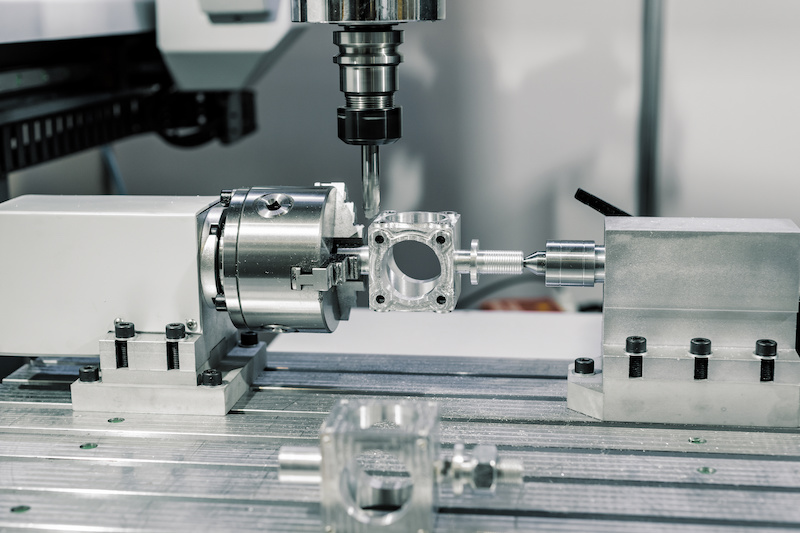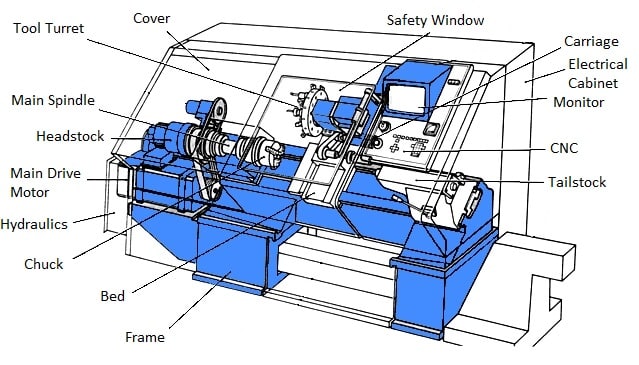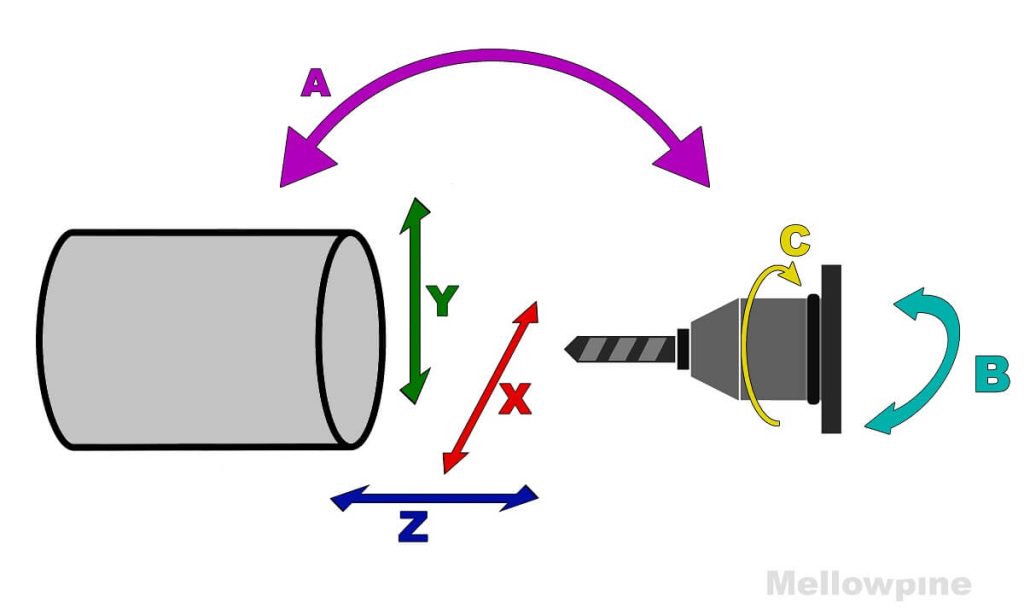Table of Contents
CNC lathes are an essential tool for precision manufacturing, and understanding the concept of bar capacity is crucial to their operation. Bar capacity is essentially the maximum diameter of a bar that can be fed through the spindle of a CNC lathe.
If you’re new to CNC machining, you may be wondering why this measurement is so important. Simply put, bar capacity determines the size of the raw material that can be used to produce your parts. In this article, we’ll take a closer look at what bar capacity is, how it’s measured, and why it matters in the world of CNC machining.
Understanding Bar Capacity in CNC Lathe
CNC lathes have become an essential tool in modern manufacturing. They are used in a variety of applications, from creating simple parts to producing complex components for aerospace and medical industries. One of the critical factors that determine the efficiency of a CNC lathe is its bar capacity. In this article, we will discuss what bar capacity is, why it’s important, and how it affects your machining process.
What is Bar Capacity?
Bar capacity refers to the maximum diameter of the material that can be fed into a CNC lathe. In simple terms, it’s the size of the bar stock that the machine can handle. The bar capacity of a CNC lathe is determined by the size of its spindle bore. The spindle bore is the hole that runs through the center of the lathe’s headstock, and it’s where the bar is inserted.
The bar capacity of a CNC lathe can vary from machine to machine. Some lathes can handle bars as small as 1/4 inch in diameter, while others can handle bars as large as 6 inches or more. When selecting a lathe, it’s essential to consider the bar capacity that meets the requirements of your project.
Why is Bar Capacity Important?
The bar capacity of a CNC lathe is essential because it determines the maximum size of the material that can be machined. If you try to machine a bar that’s larger than the lathe’s bar capacity, it can cause damage to the machine and result in poor quality parts. On the other hand, if you use a bar that’s smaller than the machine’s bar capacity, it can limit your productivity and increase your machining time.
The bar capacity also affects the type of parts that can be machined. For example, some parts require a larger bar stock to achieve the desired shape and size. If the lathe has a limited bar capacity, it may not be possible to machine these parts. Therefore, it’s crucial to select a lathe with a bar capacity that can handle the size of the bar stock required for your project.
Benefits of a Large Bar Capacity
Having a large bar capacity in your CNC lathe offers several benefits. Firstly, it allows you to machine larger parts without having to stop the machine and reload the bar stock. This increases your productivity and reduces your machining time, resulting in more efficient manufacturing.
Secondly, a large bar capacity provides you with more flexibility in your machining process. You can use a wider range of bar stock sizes, which allows you to create a broader range of parts. This flexibility also allows you to take on more complex projects and expand your manufacturing capabilities.
Bar Capacity vs. Turning Length
When selecting a CNC lathe, it’s essential to consider both the bar capacity and the turning length. The turning length refers to the maximum length of material that can be machined in the lathe. While a large bar capacity is beneficial for machining larger parts, a shorter turning length may limit the length of the parts that can be machined.
Therefore, it’s essential to select a lathe that has a bar capacity and turning length that meet the requirements of your project. If you’re unsure about the size of the parts you’ll be machining, it’s best to select a lathe with a larger bar capacity and turning length to provide you with more flexibility.
Bar Feeder Systems
Bar feeder systems are an essential accessory for CNC lathes. They allow you to load and feed bar stock into the lathe automatically, reducing the need for manual intervention. Bar feeder systems come in various sizes and configurations, and they can handle bar stocks of different lengths and diameters.
When selecting a bar feeder system, it’s essential to consider the bar capacity of your lathe. The feeder system should be able to handle the size of the bar stock required for your project. Additionally, it’s important to select a feeder system that’s compatible with your lathe to ensure proper integration and operation.
Limited Bar Capacity Workarounds
If you have a lathe with a limited bar capacity, there are some workarounds that you can use to machine larger parts. One option is to machine the part in sections and then assemble it after machining. This method can be time-consuming, but it allows you to create larger parts using a lathe with a smaller bar capacity.
Another option is to use a lathe with a larger bar capacity and then transfer the machined part to a lathe with a smaller turning length for finishing. This method requires more setup time, but it allows you to machine larger parts without having to invest in a new lathe.
Conclusion
The bar capacity of a CNC lathe is an essential factor to consider when selecting a machine for your manufacturing process. It determines the maximum size of the bar stock that can be machined, which affects the type and size of parts that can be manufactured. A larger bar capacity offers more flexibility, improves productivity, and allows you to take on more complex projects. When selecting a lathe, it’s important to consider both the bar capacity and turning length to ensure that they meet the requirements of your project.
Freequently Asked Questions
Bar capacity is an important factor to consider when using a CNC lathe. It refers to the maximum diameter of the bar stock that can be fed into the machine’s spindle. Here are some common questions and answers about bar capacity in CNC lathes:
What is Bar Capacity in CNC Lathe?
Bar capacity in CNC lathes refers to the maximum diameter of the bar stock that can be fed into the machine’s spindle. This is an important factor to consider when selecting a lathe for a specific job. The bar capacity of a lathe determines the size of the parts that can be machined and the amount of material that can be removed in a single operation.
The bar capacity of a lathe is determined by the size of the spindle bore. Larger spindle bores can accommodate larger diameter bar stock, allowing for the machining of larger parts. CNC lathes typically have a range of bar capacities, from a few centimeters to several inches in diameter.
Why is Bar Capacity Important in CNC Lathe?
Bar capacity is important in CNC lathes because it determines the size of the parts that can be machined and the amount of material that can be removed in a single operation. If the bar capacity of a lathe is too small for a particular job, it may not be possible to machine the required part. Similarly, if the bar capacity is too large for the part being machined, it may result in wasted material and longer cycle times.
Bar capacity also affects the efficiency of the machining process. Larger bar capacities allow for the use of larger cutting tools and higher feed rates, resulting in faster machining times. In addition, larger bar stock can be used, reducing the need for frequent material changes and minimizing downtime.
How to Determine Bar Capacity in CNC Lathe?
The bar capacity of a CNC lathe can be determined by measuring the diameter of the spindle bore. This measurement can be found in the lathe’s specifications or by measuring the bore directly with a caliper or micrometer. It is important to ensure that the bar stock being used is smaller than the spindle bore to prevent damage to the lathe or the part being machined.
In addition to the spindle bore, it is also important to consider the length of the lathe’s work envelope. This determines the maximum length of the part that can be machined. If the part being machined is longer than the work envelope, it may be necessary to use multiple setups or a different lathe with a larger work envelope.
What is the Maximum Bar Capacity for a CNC Lathe?
The maximum bar capacity for a CNC lathe depends on the size of the lathe’s spindle bore. Small lathes may have a bar capacity of only a few centimeters, while larger lathes can accommodate bar stock several inches in diameter. Some specialized lathes designed for large-scale manufacturing may have even larger bar capacities.
It is important to select a lathe with a bar capacity that is appropriate for the parts being machined. Using a lathe with a larger bar capacity than necessary can result in wasted material and longer cycle times, while using a lathe with a smaller bar capacity may not be able to machine the required parts.
What are the Advantages of a CNC Lathe with a Large Bar Capacity?
A CNC lathe with a large bar capacity offers several advantages over a smaller lathe. Larger bar capacities allow for the machining of larger parts, reducing the need for multiple setups or a different lathe. They also allow for the use of larger cutting tools and higher feed rates, resulting in faster machining times and increased efficiency.
In addition, larger bar stock can be used, reducing the need for frequent material changes and minimizing downtime. A CNC lathe with a large bar capacity is particularly useful for large-scale manufacturing, where efficiency and productivity are key factors.
In conclusion, understanding bar capacity in CNC lathe is crucial for any machinist looking to produce quality and efficient parts. By knowing the maximum diameter of the bar that can be used, one can optimize the machining process and minimize waste.
Moreover, the bar capacity of a CNC lathe is determined by the size of the spindle bore and the maximum length of the bar feeder. It is important to note that different manufacturers have varying bar capacities, so it is essential to check the machine specifications before starting any project.
Finally, bar capacity is not the only factor to consider when choosing a CNC lathe. Other factors such as spindle speed, chuck size, and tooling options should also be taken into account to ensure optimal performance and productivity. Overall, a thorough understanding of bar capacity is just one piece of the puzzle in the world of CNC machining.
Request a quote today!
[contact-form-7 id="1578" title="Contact form"]
Please compress the file into a ZIP or RAR file before uploading. Alternatively, send through your RFQ by email.
enquires@unitymanufacture.com





